Sometimes all Mark Grotjahn wants is to dance. Here are four five videos of those times, in chronological order:
Nov. 2007:
Jan. 2008:
May 2008:
Feb. 2011 [via artblogartblog]
May 2012:
Category: making movies
On Close Encounters, Scriabin, Schoenberg, Bernstein
OK, here are some more details about how the crazy-awesome synthesizer/lightboard came together in Close Encounters of the Third Kind, courtesy of Ray Morton’s 2007 book on the making of the film.
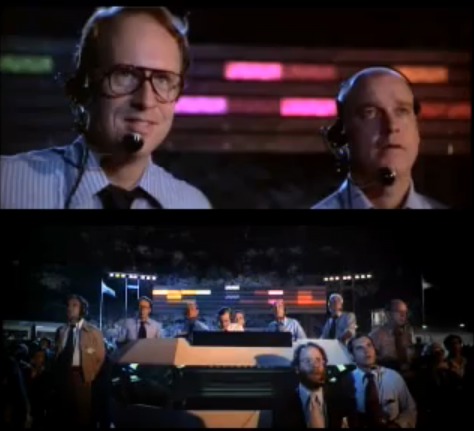
Maybe not surprisingly, it grew and evolved along with the crucial scene, known as the Box Canyon scene. Originally, Spielberg’s idea was to use run&gun documentary style film of humans meeting aliens on a very hastily constructed tent base. [the idea of the Mothership landing in a McDonald’s parking lot was nixed early on]. This grew to a runway, which became a stadium, which became a Box Canyon on the backside of Devil’s Tower.
Except that there was no way they could shoot all that at night outdoors, so they ended up moving the entire production to Mobile, Alabama, where they created the world’s largest soundstage out of a pair of WWII-era dirigible hangars, nearly bankrupting everyone in the process.
And though I mentioned Douglas Trumbull as a possible creator, Morton’s book credits Spielberg and art director Joe Alves [who, as production designer on Jaws, had also created Bruce the shark]
Inspired by Russian composer Alexander Nikolayevich Scriabin (1872-1915), who had theorized that specific musical notes prompted listeners to think of specific colors, Spielberg came up with the idea of connecting the Moog synthesizer to an array of colored lights so that each time a note was played on the Moog, a corresponding color would flash in the array. Alves suggested that the colors appear on a huge video screen but Spielberg wanted something resembling an athletic field scoreboard. Developing this idea, Alves decided to segment the board into several rows of colored rectangular panels. He then needed to find a logical way to relate the colors on the lightboard with the musical notes being played on the synthesizer. He wasn’t quite sure how to do this until he saw a television program that featured Leonard Bernstein talking about composer Arnold Schoenberg (1874-1951).
Schoenberg had devised a method of musical composition that utilized all twelve tones in the chromatic scale. Realizing that there were also twelve colors in a secondary progression on the color wheel, Alves decided to link the tones and the colors (beginning with middle C and yellow), which gave him a row of twelve rectangles running across the board. He then added three more rows on top, consisting of lighter tones and higher octaves, and two more rows on the bottom, consisting of darker tones and lower octaves, for a total of seventy-two rectangles A full-scale version of this color board would be created when the actual set was built.
First off, how hilarious that Alves got the idea of a Schoenbergian twelve-tone scale from Bernstein; Bernstein hated that shit. I’m going to guess that Alves is referring to Bernstein’s notorious Norton Lectures at Harvard in 1973, in which he argued for tonal music as a universal language against Schoenberg’s chromatic system. The lectures titled, The Unanswered Question were aired on PBS.
Previously: Close Encounters Jam Session
Untitled, By Michael David Murphy
This is so awesome. I know there’s no sound, but it seems like I can hear all those reality TV show team members’ hearts beating.
[Michael David Murphy via waxy]
Considering The Eameses As Artists
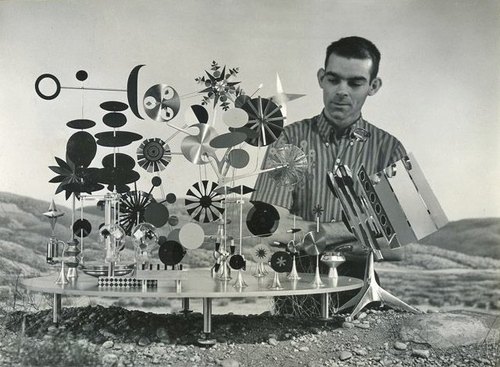
A few months ago, I was asked to write something about Ray and Charles Eames by the folks at Humanities Magazine, published by the National Endowment for the Humanities.
The NEH had provided some funding to Jason Cohn and Bill Jersey’s documentary, Charles & Ray Eames: The Architect and the Painter, so a straight-up review wouldn’t really work. But I was encouraged by the documentary’s title, and its exploration of Ray’s role in the duo’s collaborative process, and so I decided to float the idea that there’s a lot to learn by considering the Eameses as artists:
Throughout their own careers, whether making architecture, furniture, toys, annual reports, or films, the Eameses presented themselves as designers. And despite their forays into education, computing, and international diplomacy, that’s how they are typically seen. But calling the Eameses designers while trying to account for their polymathic legacy can be problematic, particularly if we’re picturing the designer as a lone, heroic genius: Charles Eames as the Howard Roark of American consumer capitalism. It invites many esoteric and academic questions about process, context, gender, and collaboration, which are interesting but hard to resolve. When considered from an artistic perspective, however, many of these complications evaporate. Accepting Ray and Charles Eames as artists and their studio work as art gets us away from the arbitrage over who did what and how. Plus, it enriches and deepens the contemporary understanding of their role in the culture of their time.
That’s John Neuhart up there, by the way; he built the Eameses’ greatest object besides their house, and one of the greatest unsung, unrecognized artworks of the modernist era, the Solar Do-Nothing Machine.
Modern Love, Humanities Magazine, Nov/Dec. 2011 [neh.gov]
The EAI High Definition Video Guide
Whether you’re sitting at home, poking at your remote to stretch, squash, and crop your Criterion movies; or preparing a video group show in Miami, Electronic Arts Intermix’s High Definition Video Guide is an indispensable source of basic technical information:
If we agree that mindfulness about the proper display of electronic art is necessary to maintain the integrity of the work, then a basic awareness of how this new medium works is crucial. In what ways is HD different from other forms of video? How do these factors visibly affect the picture? How can older analog works be properly displayed with today’s technology? All in all, how will HD video impact collection, exhibition and preservation?
This addendum to EAI’s Online Resource Guide explains HD technology and its implications for curators, conservators, registrars, art historians and educators. The goal is not to mandate best practices, but to offer the foundation of a consistent vocabulary. Even more, the aim is to initiate dialogue across the field about the challenges and possibilities in this new chapter in the history of the moving image.
Thanks to Ed Halter of Light Industry, who included EIA’s HD Guide in his Best of 2011 list in Artforum.
On Bruce McAllister’s DOCUMERICA And Robert Smithson’s Spiral Jetty

One of the startling images Alan Taylor included from the EPA’s DOCUMERICA collection is by Bruce McAllister. The caption:
A train on the Southern Pacific Railroad passes a five-acre pond, which was used as a dump site by area commercial firms, near Ogden, Utah, in April of 1974. The acid water, oil, acid clay sludge, dead animals, junked cars and other dump debris were cleaned up by several governmental groups under the supervision of the EPA. Some 1,200,000 gallons of liquid were pumped from the site, neutralized and taken to a disposal site.
Hmm, is that the only photo McAllister took of railroads and toxic industrial dumps near Ogden in the early 1970s?
No.

“THE UNION PACIFIC RAILROAD’S CAUSEWAY ACROSS THE GREAT SALT LAKE THREATENS THE ECOLOGICAL BALANCE OF THE LAKE, 07/1972”
McAllister’s acid pond is “near Ogden,” but it turns out it was even nearer the Great Salt Lake. The site was called Little Mountain Salvage.
Continue reading “On Bruce McAllister’s DOCUMERICA And Robert Smithson’s Spiral Jetty”
Close Encounters Jam Session
I’m sure the original’s long gone, but I want the Moog synthesizer-equipped lightboard from Close Encounters of the Third Kind.

The idea of communicating with extraterrestrials via “a basic tonal vocabulary” synched to a gridded light show is like the lovechild of Carl Sagan and Ellsworth Kelly, conceived at an outdoor Pink Floyd concert. In a good way.
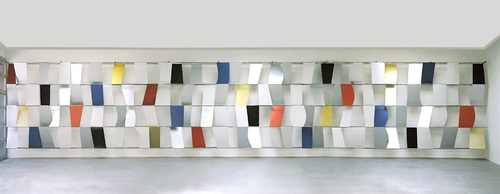
Sculpture for a Large Wall, 1957, image: moma.org
[Just an aside, the story of Kelly’s Sculpture for a Large Wall is utterly fantastic. I’m glad that it’s safe and at MoMA, but the utter failure of Philadelphia to keep it should be discussed every time the Eakins or Barnes stories are told.]
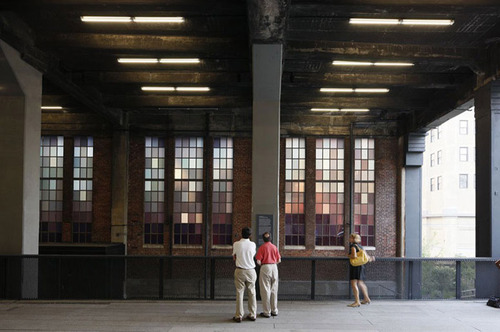
Spencer Finch, The River That Flows Both Ways, image by iwan bann via thehighline
I would have expected Spencer Finch or Leo Villareal to have made one of these already. Or any one of a number of early Silicon Valley IPO nerds. But I can’t find any record of replicas anywhere. So I will step in where I must.
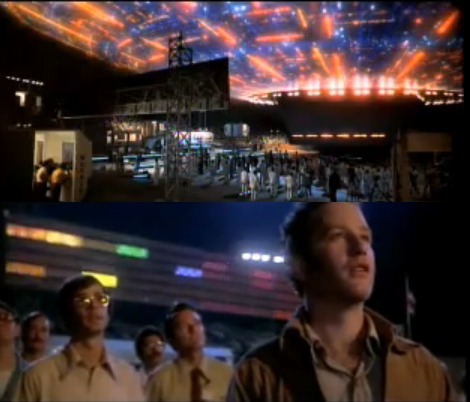
My first guess was that Douglas Trumbull gets the credit for the board; and maybe he designed and executed it. But according to Ray Morton’s definitive-sounding 2007 book on the making of Close Encounters, it was Spielberg’s idea to have a colored lights that correspond to each Moog tone. John Williams composed and recorded the music in advance, so it could be played back on set for filming what was called “the jam session.” I’ll gladly overlook this somewhat Milli Vanillistic approach to jamming in exchange for the score and the rig’s schematics.
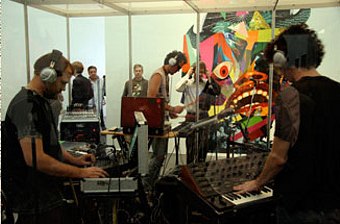
Rirkrit Tiravanija, Untitled (Rehearsal Studio No. 6, Silent Version), 1996, installed at MCA Chicago, image via artforum
Because obviously, when you exhibit this, you’ll expect the first thing everyone will play is that iconic five-note greeting. Then they’ll get into a jam session of their own. You’d probably want to make it possible, via the web or USB stick or something, for people to execute their own compositions, to let the computer “take over the conversation” once in a while. And you’d probably stream the piece over the web, too, give it its own channel. Maybe schedule some performers to come in and use it.
Then for good measure, put the whole thing on a golden CD and launch it into space, and wait for a response.
Off the Golden Record
The View Of Punishment Park From Zuccotti Park
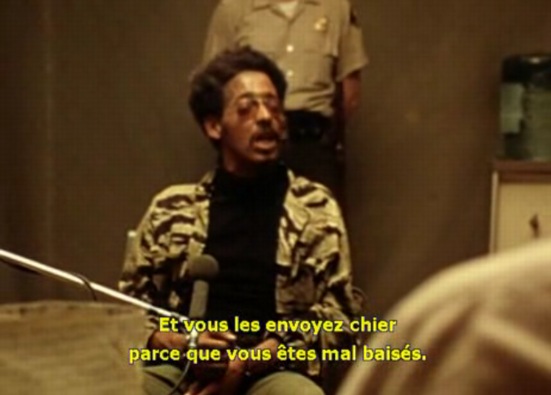
Punishment Park? How did I not know about Peter Watkins’ incendiary 1971, anti-war, anti-fascist, faux-news documentary? I mean, it was the movie Rirkrit chose to broadcast on his unlicensed TV station in the Guggenheim. I sat in Anthology’s rickety seats for the entire 5+ hours of The Commune (Paris, 1871). Is it one of those things that just looks so completely, unrecognizably different in the light of Occupy Wall Street, that–no.
When Punishment Park was finally released on DVD in 2005, it was the peak of a globally unpopular war, which was tainted by torture, unlawful detainment and military tribunals, violations of basic constitutional and human rights, and polarized rhetoric within American culture. So no, I don’t think I registered what Watkins had done.
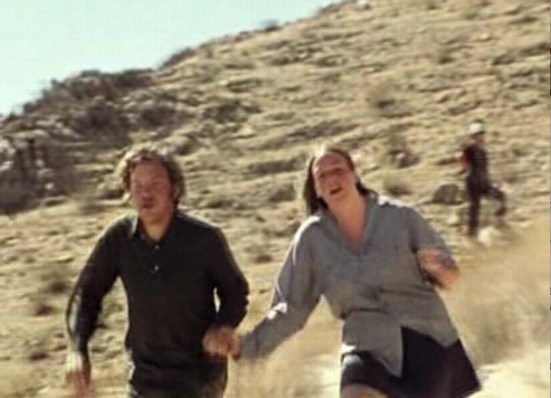
Which, holy smokes. Here’s how Holland Cotter describes Punishment Park in his 2005 review of Rirkrit’s show:
it is a docudrama about the brutal silencing of antiwar protesters during the Vietnam period. Many of the actors were amateurs. The people cast as activists were, in fact, real-life activists; the police were played by former police officers.
Their lack of theatrical training gives the film a curious tension, making it seem both authentically documentary and stagy. It feels something like that era’s political street theater, which was cropping up all over the United States and Europe at a moment when anger and paranoia were at flood tide. This aesthetic certainly suits the low-tech character of the broadcast facilities, which are pretty rudimentary.
Shooting in an army tent and the Mojave Desert, a British news crew follows two groups of activists/protestors as they are run through a sham tribunal and are given the choice between excessive federal prison sentences and an impossibly brutal three-day race across a vast desert reservation, aka “Punishment Park,” where they are hunted down by National Guardsmen training for the next Kent State.
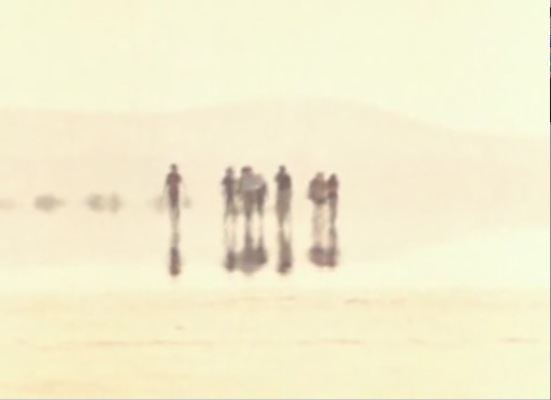
It’s like Predator and The Tenth Victim gave birth to the sequel of Zabriskie Point, starring the Chicago Seven. It is not pretty.
Punishment Park may not be a great movie, but it is definitely a fascinating one, one which is difficult to watch, and apparently difficult to like. I think that’s by design, though; it seems calculated to antagonize and/or enrage basically anyone with a political opinion and a stake in the outcome of the American experiment. It deserved a little more credit than it got, though, and certainly better consideration than Vincent Canby was capable of:
Because all literature, including futuristic nonsense like this, represents someone’s wish-fulfilling dream, I can’t help but suspect that Watkins’s cautionary fable is really a wildly sincere desire to find his own ultimate punishment.
Yow.
The freaky thing, I guess, is the way Punishment Park manages to both over- and under-predict the cultural rifts and abuses of power in American politicized culture over the intervening 40 years. I think had I seen Punishment Park in 2005, I would have distanced it as a historic, histrionic artifact. But given the last few years/months/weeks, I can’t help but see parallels and hear echoes between the film, its time, and today.
The other, less uncomfortable thing–I mentioned Zabriskie Point for a reason–is how Punishment Park alters the context of the 60s and 70s for me. I can’t help but see the counterculture and the desert, the military and the desert, war and the desert, art and filmmakers in the desert, quite differently now.
The New Yorker Films DVD release of Punishment Park is available on Amazon and Netflix.
Israeli Air Force Has Huge Belgian Balls
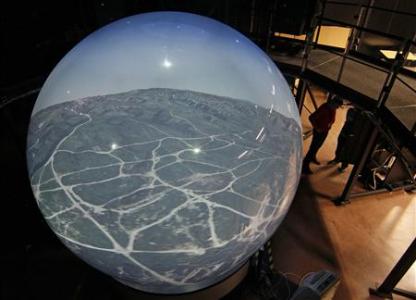
Speaking of huge, impressive balls, Reuters reports that a Belgian firm called Barco is delivering its first order of eight, brand new, 360-degree flight simulators, each of which is a 3.4 meter-diameter cast acrylic sphere. The sphere is ringed by thirteen hi-res projectors, whose images are all laser-stitched together or something in some suitably seamless way.
Alls I know is, 10-foot-wide acrylic sphere screen. Also, Top Gun? Really?
Belgian firm unveils new Top Gun flight simulator [reuters via boingboing]
‘The Movie Is Called Eden Rock…’
It’s all in the book, so you could definitely buy it and read about it in depth, but it didn’t occur to me until Brian Dupont tweeted about it [“Aspen : #OccupyWallSt :: St. Barts : Canal Zone. Every apocalypse needs a last stand.”], that there might be a connection between the Occupy Wall Street protests and Richard Prince’s movie pitch.
See, in defending his Canal Zone paintings against Patrick Cariou’s copyright infringement claims, Prince and his lawyers repeatedly cited The Pitch, a 1.5 page text for a post-nuclear apocalyptic movie called Eden Rock in which Cariou’s Yes Rasta photo subjects were one of several tribes. The strategy–failed so far–was apparently to demonstrate how completely Prince had transformed Cariou’s work, thus obviating the infringement claim.
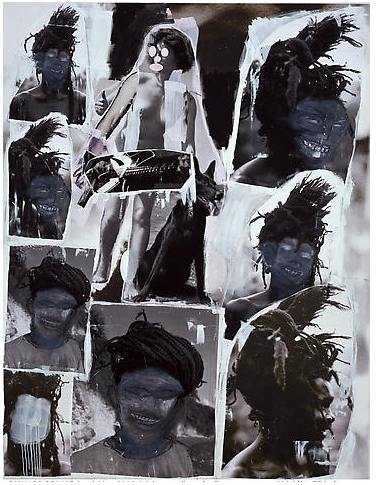
Prince included the The Pitch text in Eden Rock Show, a brief 2007 exhibit of a large collage/painting made up of pages from Yes Rasta at St. Bart’s Eden Rock Hotel. It was included in court exhibits in Cariou v. Prince and, like I said, is in the Selected Court Documents &c. book.
When I started typing this, the way I had remembered The Pitch had me thinking it is occasionally starting to sound like a future documentary, minus the global thermonuclear war part. Now that I’ve re-read and typed it all in I don’t think that anymore. But I’m not so sure Prince agrees with me. But as the view from his position as a pessimistic artist in the lower reaches of the 1%, but not of the 1%, it does have a certain authenticity, and so I thought The Pitch is worth posting:
The Pitch
Charles Company, his wife, son and daughter arrive at the St. Barts airport, late afternoon two days before Xmas, he’s meeting up with his brother and sister-in-law… staying on the island for a couple of weeks…vacation…As he’s landing, he sees out the window a lot of people running around…general commotion.
As the plane taxis up to the gate he asks the pilot what’s going on…
As the Company family disembarks the plane, there’s more pandemonium…
People grabbing, shouting, some hysterical…it’s a tiny airport, but there’s an overload of people waiting to get thru customs and many people literally “crying”…they’re “crying because there are no planes going out…no planes returning to St. Martins…returning to Miami…returning to NYC…returning to London…returning anywhere…
There are no returning flights because these cities and many other major “areas” in the continental U.S. and Western and Eastern Europe have just been obliterated by nuclear attack.
Charles Company and his family are informed of this fact and seemed to melt into the tarmac under 88 degree temps…holding their bags, their backpacks…what will come to be as all their worldly possessions.They hook up with Charles’s brother, who will fill them in with a bit more detail on the events “round” the world. “What are we suppose to do?” is Charles’s wife’s first question…
“There’s nowhere to go”, is the first answer.A good part of the world, “most” of the world, has been nuked and they are here on a tiny French island in the middle of nowhere…which in a year’s time will become part On the Beach, part Lord of the Flies.
Background: Charles is 55, has no military background, is pretty much out of shape…makes his living as an architect.
To make this pitch even shorter I’m going to cut to a year later…
People on the island have broken up into “tribes”…most of the houses have been ransacked and all of the hotels occupied.
Charles Company is now Charlie Company. He has been exercising. Hes also learned to load a weapon, field dress a wound, cook without a fire. His daughter is the #1 scavenger…
He his wife, son and daughter, brother and sister-in-law, (along with several followers) have taken over the Eden Rock Hotel. It’s headquarters.Stockpiled. A Mini-Mart. As best a fortress as can be under the circumstances. Everything is rationed, everything is “used”…
Next: Charles’s son is standing lookout. Thru his telescope out in the ocean he sees what appears to be a periscope…he sounds the alarm…The movie is called Eden Rock…
[from an October 2008 email prepping for the Canal Zone show at Gagosian]
Additional Eden Rock/Pitch Material written MARCH 2008–
More on Eden Rock
1. Rastas and Reggae…they escape from one of the Cruise ships, (they were the band aboard the ship) three days after the bombs went off. They go to the Hotel Manapany. Six band members, two roadies and a manager.
2. The Backpackers…these are college kids, use to spring breaks, know nothing of responsibility or the real world.
They gather first in bars then take over a small hotel just above Shell Beach. They keep partying, drinking, smoking..they are the first to “go native”…the first to smear “war paint” on their bodies…they’re also the first to get wiped out…3. The Amazons…Four Lesbians who escape a second Cruise ship, who bring along part of hte crew and take over the Guanahani Hotel. These are large well built women along the lines of Shena Queen of the Jungle, Wonder Woman, Cat Woman, think Raquel Welch meets Linda Hamilton in the Terminator. Their outfits, hair and make-up remind us of Road Warriors…
4. The Ultimate Ones…this tribe is made up of rich, affluent masters of the universe…these are guys who own the huge private boats parked in Gustavia…they have the loyalty of their crews, they have their own weapons and in the beginning access to food and water. They quickly make deals with the local St. Bart police force. They stay on their boats at first but then take over the Ill de France hotel…these guys are use to privilege and shaping the future…they don’t take “no” for an answer…they believe they “own” the island and everyone is their subject…several come to be assassinated, held hostage, and hanged upside-down…in an opening scene one of them is pictured buried up to his head in the sand at Saline Beach with the tide coming in…
These are the four main tribes along with Charlie Company…
Charlie Company represents “family”
Rastas and Reggae represents “The disenfranchised”
Backpackers represent “alternative”
Amazons represent “sex”
Ultimate Ones represent “power”Richard Prince
—– End of Forwarded Message
[spelling and punctuation original]
Previously: Canal Zone Richard Prince Yes Rasta: The Book
Hirayama Masanao Mylar Ghost Master
If I’ve accomplished little else with my grandiose ambitions for my satelloon fetish, it has at least turned me into several people’s go-to guy for odd projects involving shiny balls and/or large amounts of Mylar.
So thanks Michael Dumontier of Stopping Off Place for passing along this video short, Masanao Hirayama Memory Master, which is thoroughly awesome.
Hirayama is a Tokyo-based zine artist, and from the timing and the decor, I would guess this was made as part of Hon to Sakuhin (Books and Works), his just-closed exhibition at Pantaloon, a design/event firm in Osaka. The show traveled the Japanese art book circuit, starting out at Edition Nord and Utrecht in Tokyo.
The un-Google Translate-able single jpg website for the Pantaloon show mentions a transformed cafe, video, and “movie-like sequences,” but has no mention of silent Mylar spirits.
Hirayama Masanao’s website, HIMAA [himaa.cc]
Hirayama Masanao show at Pantaloon, 8.20 – 9.25.2011 [pantaloon.org]
The Until The End Of The World Is Nigh
I’m going to assume you’re as freaked out as I am that neuroscientists at UC Berkeley have constructed video from the brain activity of what someone is seeing. Gizmodo has a bit longer explanation of the research, and here’s a making of video, but basically it involves mapping the brain into voxels [volumetric pixels], and monitoring activity across the brain with an fMRI scanner while the person watches video, and then reverse engineering the imagery from the voxellated activity. Once a database of visual/voxel connections was created, they could replicate the process with new video.
And so now they can see the images inside your head.
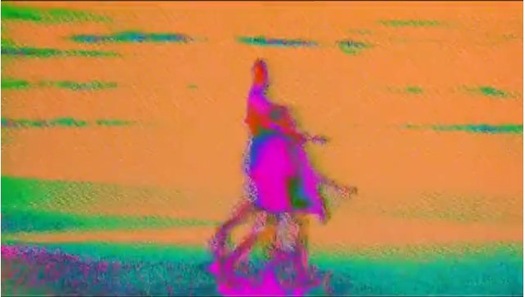
Which is all freaky enough–even if it didn’t end up looking exactly like Wim Wenders said it would, twenty years ago. BUT IT DOES.
Wenders’ 1991 film, Until The End Of The World is set in 1999, where a neuroscientist’s son [William Hurt] is being chased around the world as he records the neural record of images with a secret device that will enable his blind mother to play them back, and thereby see again. After all the electronics in the world are wiped out by the EMP blast from nuking a renegade satellite that’s about to crash into the earth [holy crap, people], the neuroscientist [Max von Sydow] converts the device to read dreams. And then moody, overwrought German actresses [Solveig Dommartin] become addicted to watching their dreams until the batteries run out. Because seriously, who could have predicted the iPad’s amazing battery performance, amiright?
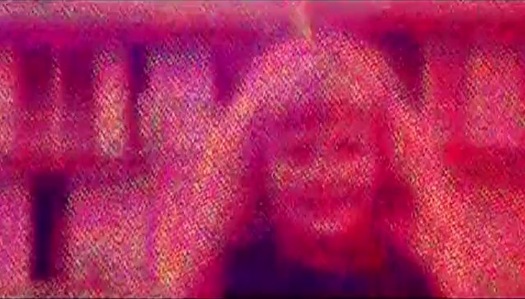
Anyway, Until The End Of The World was the first film to use HD, for the dream sequences, which were developed with NHK. And this is what they look like.
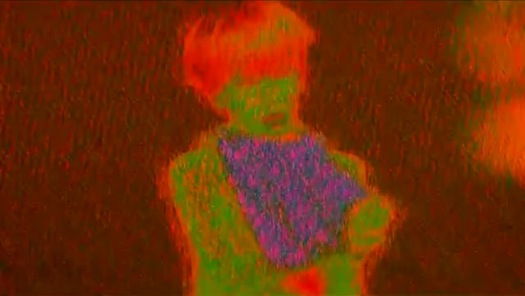
Here’s the Dream Junky scene on Vimeo, taken from the original theatrical cut.
Wenders was never satisfied with the 158-minute version released in the US, which he had cut down from a “definitive,” 280-minute, director’s cut. In 2001, the director revealed that he had kept the uncut negative of the film, and that the original, chopped version he had handed over to the distributor in 1991 had been a duplicate positive. And so he was able to re-create his original 280-min version from the original negative. Which he did, and which was released on DVD in 2004.
He presented the director’s cut in 2001 at a screening at DGA in New York. The Q&A didn’t start until after midnight.
part 2, part 3 [which has a fascinating story about using Vermeer as a visual inspiration, about 10:00 in, and then aroun 12-13m, he starts talking about the dream sequences] and part 4 [cont’d].
Until the End of the World (Bis ans Ende der Wel ) (Jusqu’au bout du monde) on four Region 2 DVDs
It’s All About The Tiravanijas, Baby
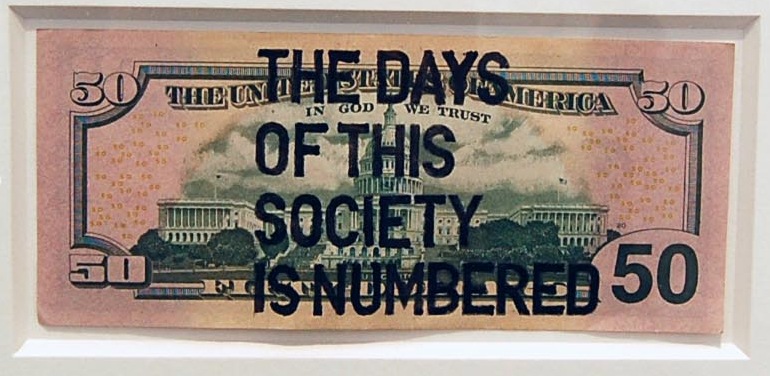
Rirkrit Tiravanija, ink on paper, shown at Gavin Brown’s Enterprise in Nov-Dec 2008 as part of JG Reads, image: detail of a shot by James Nova from the opening. j-No has more images of two other dollar bill drawings.
Here’s a 2 min or so clip of the 10h16m film, shot that summer in Giorno’s Bowery studio.
For details of the show, check out contemporary art daily.
The Glancer Is Present
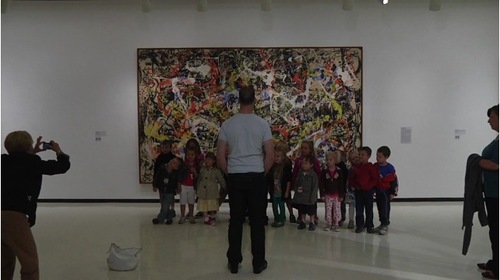
For his performance/project The Long Glance, Brooklyn-based artist Jonathan VanDyke spent 40 hours standing in front of and looking at Jackson Pollock’s painting Convergence, 1952 at the Albright-Knox Gallery in Buffalo. He carried this out over the course of one week last May/June, looking for eight hours/day, for five straight days.
The Long Glance was streamed live on the museum’s website, and he had his own wall label in the gallery which described him as a “living sculpture.” Hmm.
Artist Sal Randolph wrote about watching VanDyke online as he watched the Pollock.
The project and its audience all seem to have a resonance with The Artist Is Present, except, obviously, the artist’s counterpart here is a painting, not a person.
Thinking about these two projects together makes me interested to hear what VanDyke saw, and what he learned about Convergence, or about its creation, or its creator. Which is kind of funny, because I never had that sense about sitting with Marina Abramovic. I mean, sure, there were people who cried or emoted or developed relationships of some kind with her through sitting. But I always had a sense that the experience of sitting with Marina was its own objective, while looking at a painting is a means to an end: understanding.
And so I’m a little disappointed with VanDyke’s essay about The Long Glance because, while it is highly informed and expansive, it is almost entirely about the internalities of his own experience. Which is great, don’t get me wrong, just.
But maybe I’m missing the point: both VanDyke’s, and Pollock’s. In another post about The Long Glance, Randolph quotes extensively from Alan Kaprow’s 1958 examination of the experiential nature of Pollock’s Action Paintings:
The space of these creations is not clearly palpable as such. We can become entangled in the web to some extent and by moving in and out of the skein of lines and splashings can experience a kind of spatial extension. But even so, this space is an allusion far more vague than even the few inches of space-reading a Cubist work affords. It may be that our need to identify with the process, the making of the whole affair, prevents a concentration on the specifics of before and behind so important in a more traditional art. But what I believe is clearly discernible is that the entire painting comes out at us (we are participants rather than observers), right into the room.
OK, then, carry on.
The Long Glance, by Jonathan VanDyke [thepowerplant.org via wordobject]
The Long Glance (5 of 2400 minutes) [vimeo]
Action: Watching the Watcher [wordobject]
Action: Inaction Painting [wordobject]
Filming Gerhard Richter Painting
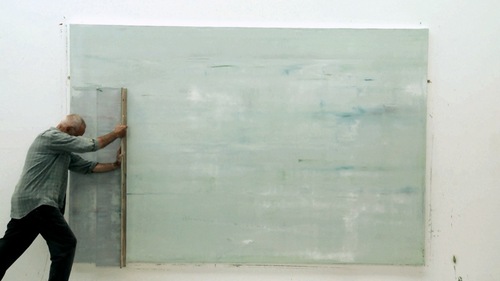
Gotta get a piece of that Gerhard Richter Painting. After completing a documentary about the artist’s Cologne Cathedral stained glass windows in 2007, filmmaker Corinna Belz began working on another project, filming Richter at work in his studio. She waited a year and a half for the artist to begin a new series of abstract paintings, and then she pretty much filmed the whole process.
It’s kind of crazy how jazzed I am after just watching the trailer. Those squeegees are so huge. And they’re clear. And he wields them by hand. Some of this we [I] knew, but it’s still kind of riveting to watch. Belz in an interview:
Books are a better medium to articulate theoretical positions. And the actual act of painting is hard to describe in words: The way Richter mixes primary colours on the canvas, generating such a complex colour system. How layers are built up and submerged, how sculptural they appear on canvas. The most important thing for me in this film was to show something uniquely visual.
In related news, I now have new iPad wallpaper [above].
Gerhard Richter Painting, dir. Corinna Belz [gerhard-richter-painting.de via scahweb]
